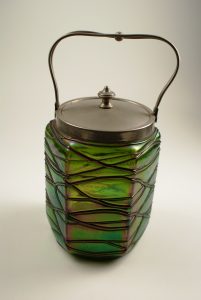Art Nouveau Lidded Box - German/German

The green biscuit tin was made around 1900 in Steinschönau, Bohemia. The tin by the Pallme & König company, which has a metal handle, is captivating not only because of its size of 20 centimetres, but above all because of its shimmering green luster. The iridescent, so-called iris glass in the colours of the rainbow is typical of Art Nouveau. "Iris" comes from the ancient Greek and means rainbow. The iridescence effect is created by vapour-depositing metal salts onto the surface of the glass. The type of metal salts, the temperature and the type of glass determine the iridescent play of colour in the glass. Crystal glass or hyalite glass are best suited.
The Art Nouveau huts were inspired by the natural lustre of antique glass. Due to the long storage under the ground, foreign particles were able to penetrate the porous surface. This is how beautiful iridescence was created in a completely natural way.
What is striking about the biscuit tin, apart from its hexagonal shape, are the irregular glass threads running over the entire wall - a characteristic of the Pallme & König company, which was founded in 1786.
Art Nouveau Container with Lid - English

This green biscuit barrel was made in Steinschönau in Bohemia in around 1900. This container with its metal handle produced by the Pallme & König company is made appealing by its 20 cm height and above all its green shimmering lustre. The iridescent glass that shimmers in the colours of the rainbow is typical of the art nouveau style. "Iris" contained within the word "iridescent," comes from ancient Greek and means rainbow. The evaporation of metal salts on the glass surface create the iridescent effect, and the type of salts, the temperature and the type of glass also determine the type of shimmering effect on the glass surface. Crystal glass or Hyalite glass is best suited to this process.
The natural shimmer of antique glass inspired workers at the art nouveau glass foundries. A long period of storage under the earth meant that foreign particles could penetrate the porous surface and create a natural and beautiful iridescence.
Apart from the hexagonal shape of this biscuit barrel the irregular glass threads that run all over the surface also make it very striking - this was a hallmark of the Pallme & König company founded in 1786.